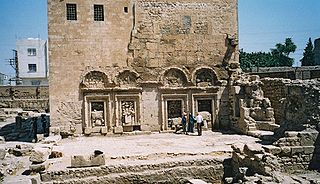Related Research Articles
John III of the Sedre was the Patriarch of Antioch and head of the Syriac Orthodox Church from 631 until his death in 648. He is commemorated as a saint by the Syriac Orthodox Church, and his feast day is 14 December.
Athanasius II Baldoyo, also known as Athanasius of Balad, and Athanasius of Nisibis, was the Patriarch of Antioch and head of the Syriac Orthodox Church from 684 until his death in 687.
Quriaqos of Tagrit was the Patriarch of Antioch, and head of the Syriac Orthodox Church, from 793 until his death in 817. He is commemorated as a saint by the Syriac Orthodox Church in the Martyrology of Rabban Sliba, and his feast day is 13 or 16 August.

The Metropolitanate of Nisibis was an East Syriac metropolitan province of the Church of the East, between the fifth and seventeenth centuries. The ecclesiastical province of Nisibis had a number of suffragan dioceses at different periods in its history, including Arzun, Beth Rahimaï, Beth Qardu, Beth Zabdaï, Qube d’Arzun, Balad, Shigar (Sinjar), Armenia, Beth Tabyathe and the Kartawaye, Harran and Callinicus (Raqqa), Maiperqat, Reshʿaïna, Qarta and Adarma, Qaimar and Hesna d'Kifa. Aoustan d'Arzun and Beth Moksaye were also suffragan dioceses in the fifth century.
Zuqnīn Monastery was a Syriac Orthodox monastery near Diyarbakır in Turkey. It produced one patriarch and fourteen bishops.
Marutha of Tikrit was the Grand Metropolitan of the East and head of the Syriac Orthodox Church of the East from 628 or 629 until his death in 649. He is commemorated as a saint by the Syriac Orthodox Church.
Elias I of Antioch was the Patriarch of Antioch and head of the Syriac Orthodox Church from 709 until his death in 723. He is commemorated as a saint by the Syriac Orthodox Church in the Martyrology of Rabban Sliba, and his feast day is 3 November.
Athanasius I Gammolo was the Patriarch of Antioch and head of the Syriac Orthodox Church from 594/595 or 603 until his death in 631. He is commemorated as a saint by the Syriac Orthodox Church in the Martyrology of Rabban Sliba, and his feast day is 3 January.
Iwannis I was the Patriarch of Antioch and head of the Syriac Orthodox Church from 739/740 until his death in 754/755.
Athanasius IV Salhoyo was the Patriarch of Antioch and head of the Syriac Orthodox Church from 986/987 until his death in 1002/1003.
Ignatius II was the Patriarch of Antioch and head of the Syriac Orthodox Church from 878 until his death in 883.
Severus II bar Masqeh was the Patriarch of Antioch and head of the Syriac Orthodox Church from 667/668 until his death in 684. He is commemorated as a saint by the Syriac Orthodox Church.
Theodosius Romanus was the Patriarch of Antioch and head of the Syriac Orthodox Church from 887 until his death in 896.
Dionysius II was the Patriarch of Antioch and head of the Syriac Orthodox Church from 896/897 until his death in 908/909.
Julian II, also known as Julian the Roman or Julian the Soldier, was the Patriarch of Antioch and head of the Syriac Orthodox Church from 687 until his death in 708.
Athanasius Sandalaya, also known as Athanasius Sandloyo or al-Sandali, was the Patriarch of Antioch, and head of the Syriac Orthodox Church from 756 until 758.
The Chronicle of 846 is a fragmentary universal chronicle written in Syriac by an anonymous author sometime between 846 and 873. Its focus for the later centuries, where it is most valuable, is ecclesiastical history. It is written from a Syriac Orthodox perspective.
The Chronicle of 819, also called the Chronicle of Qarṭmin, is a chronological table of important events and people from the birth of Jesus down to the year AD 819 written in Syriac by an anonymous Miaphysite monk from the monastery of Qarṭmin. It contains lists of the Abbasid caliphs for 785–813 and the Syriac Orthodox patriarchs for 788–819.
Athanasius III was the Patriarch of Antioch and head of the Syriac Orthodox Church from 724 until his death in 739/740.
References
- ↑ Palmer (1990), p. 192.
- ↑ Moosa (2014), p. 513; Mazzola (2018), pp. 254–255.
- ↑ Moosa (2014), pp. 507, 511.
- ↑ Moosa (2014), p. 513; Wilmshurst (2019), p. 807.
- ↑ Mazzola (2018), pp. 254–255.
- ↑ Evetts (1904), pp. 364–365; Palmer (1990), p. 170.
- ↑ Evetts (1904), p. 208.
- 1 2 Evetts (1904), pp. 208–212.
- ↑ Evetts (1904), pp. 208–212; Harrak (1999), p. 192; Moosa (2014), p. 513.
- ↑ Palmer (1990), p. 170.
- ↑ Palmer (1990), p. 13; Moosa (2014), p. 514.
- ↑ Fiey (2004), p. 98.